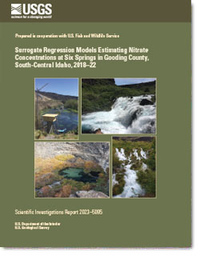Surrogate Regression Models Estimating Nitrate Concentrations at Six Springs in Gooding County, South-Central Idaho, 2018–22
Links
- Document: Report (3.8 MB pdf) , HTML , XML
- Data Release: USGS data release - Surrogate regression model data for estimating nitrate concentrations at six springs in Gooding County, south-central Idaho
- Download citation as: RIS | Dublin Core
Abstract
Populations of endangered Banbury Springs limpet (Idaholanx fresti) and threatened Bliss Rapids snail (Taylorconcha serpenticola) are declining in springs north of the Snake River along the southern Gooding County boundary, in south-central Idaho. One hypothesis for the decline is that increased macrophyte growth, associated with elevated nitrate concentrations in the springs, is decreasing aquatic habitat for the limpet and snail populations. In support of U.S. Fish and Wildlife Service efforts to understand the population declines, the U.S. Geological Survey developed surrogate regression models to estimate nitrate concentrations at six springs influenced by upgradient agriculture, which results in an increase and decrease each year of streamflow, specific conductance, and nitrate concentrations. The surrogate regression models use continuous specific conductance data and streamflow data (available at two springs from existing U.S. Geological Survey streamgages).
The spring surrogate regression models showed that specific conductance can be an effective surrogate for nitrate in springs affected by agriculture and that the model results improved when streamflow data were included. Four of the six springs had surrogate regression models (using specific conductance and day of the year as explanatory variables) that performed well based on model summary statistics, and these models improved further with the inclusion of streamflow as an explanatory variable. The surrogate regression models at four springs had coefficient of determination (R2) values ranging from 0.79 to 0.94. The root mean squared error of the four models ranged from 0.07 to 0.11 milligrams per liter. Two of the six springs were not well modeled, with adjusted R2 values of 0.15 and 0.80. The surrogate regression models for these two springs also did not meet the required assumption of linearity between explanatory and response variables for linear regression. The surrogate regression models show that specific conductance can be an effective surrogate for nitrate in springs affected by agriculture and that models are improved where streamflow data are included. These surrogates improve understanding of nitrate concentration variability in the springs.
Suggested Citation
Skinner, K.D., 2023, Surrogate regression models estimating nitrate concentrations at six springs in Gooding County, south-central Idaho, 2018–22: U.S. Geological Survey Scientific Investigations Report 2023–5095, 22 p., https://doi.org/10.3133/sir20235095.
ISSN: 2328-0328 (online)
Study Area
Table of Contents
- Acknowledgments
- Abstract
- Introduction
- Methods
- Nitrate Surrogate Regression Model Results
- Discussion
- Summary
- References Cited
| Publication type | Report |
|---|---|
| Publication Subtype | USGS Numbered Series |
| Title | Surrogate regression models estimating nitrate concentrations at six springs in Gooding County, south-central Idaho, 2018–22 |
| Series title | Scientific Investigations Report |
| Series number | 2023-5095 |
| DOI | 10.3133/sir20235095 |
| Publication Date | August 31, 2023 |
| Year Published | 2023 |
| Language | English |
| Publisher | U.S. Geological Survey |
| Publisher location | Reston, VA |
| Contributing office(s) | Idaho Water Science Center |
| Description | Report: vii, 22 p.; Data Release |
| Country | United States |
| State | Idaho |
| County | Gooding County |
| Online Only (Y/N) | Y |


